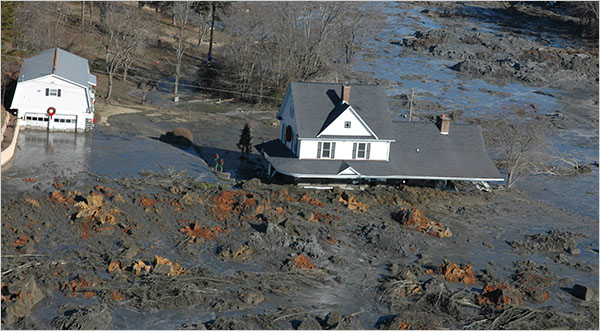 [Image: Sludge makes itself at home in Harrimann, Tennessee; photo by J. Miles Carey/Knoxville News Sentinel, via Associated Press/New York Times].
[Image: Sludge makes itself at home in Harrimann, Tennessee; photo by J. Miles Carey/Knoxville News Sentinel, via Associated Press/New York Times].Earlier this week the retaining wall of a massive sludge dam gave way 40 miles west of Knoxville, Tennessee, resulting in a coal ash spill that now lies "thick and largely untouched over hundreds of acres of land and waterways."
Houses and business have been buried whole or swept off their foundations by the potentially toxic material; amidst its unnaturally concentrated ingredients are selenium, arsenic, and lead, all of which produce "neurological problems" and cancer.
"The breach occurred," the New York Times explains, as if describing a painting by from a little-known Appalachian Series by Caspar David Friedrich, "when an earthen dike, the only thing separating millions of cubic yards of ash from the river, gave way, releasing a glossy sea of muck, four to six feet thick, dotted with icebergs of ash across the landscape. Where the Clinch River joined the Tennessee, a clear demarcation was visible between the soiled waters of the former and the clear brown broth of the latter."
An updated aerial survey now suggests that more than 5 million cubic yards of this possibly neurologically-active waste has been released – "enough to flood more than 3,000 acres one foot deep" – forming a new self-organized landscape of industrial byproducts, a future stratigraphic surprise for our next millennium's archaeologists.
Or perhaps this is the metallization of the world long ago dreamed of by the Italian futurists. Adventures in metallized deterrestrialization.
No comments:
Post a Comment